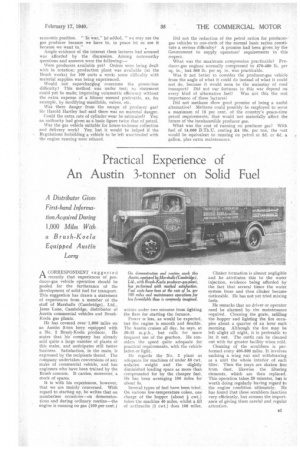Practical Experience of An Austin 3-tonner on Solid Fuel
Page 27

If you've noticed an error in this article please click here to report it so we can fix it.
A Distributor Gives First-hand Information Acquired During 1,000 Miles With a Brush-Koela Equipped Austin Lorry
A CORRESPONDENT suggested r-t recently that experiences of producer-gas vehicle operation should be pooled for the furtherance of the development of solid fuel for transport. This suggestion has drawn a statement of experiences from a member of the staff of Marshal's (Cambridge), Ltd., _Jesus Lane, Cambridge, distributor of Austin commercial vehicles and BrushKoala gas plants.
He has covered over 1,000 miles on an Austin 3-ton lorry equipped with a No. 2 Brush-lcoela producer. He states that his company has already sold quite a large number of plants of this make, and anticipates still better business. Satisfaction, in the main, is expressed by the recipients therof. The company undertakes conversions of any make of commercial vehicle, and has engineers who have been trained by the Brush concern. It carries, moreover, a stock of spares.
It is with his experiences, however, that we are mainly concerned. With regard to starting up, he writes that on numberless occasions—on demonstrations and during ordinary routine—the engine is running on gas (100 per cent.)
within under two minutes from lighting the flare for starting the furnace.
Power is less, as would be expected, but the engine is smooth and flexible. The Austin cruises all day, he says. at 30-35 m.p.h., but calls, for more frequent use of the gearbox. He considers the speed quite adequate for practical requirements, with the vehicle laden or light.
He regards the No. 2 plant as adequate for machines of under 50 cwt. unladen weight and the slightly diminished loading space as more than compensated for by the cheaper fuel. He has been averaging 100 miles for about 5s.
Several types of fuel have been tried. On various low-temperature cokes, one
charge of the hopper (about cwt.) takes the machine 40 miles, whilst a fill of anthracite (1 cwt.) does 100 miles.
Clinker formation is almost negligible and he attributes this to the water injection, evidence being afforded by the fact that several times the water system froze and then clinker became noticeable. He has not yet tried mixing fuels.
He remarks that no driver or operator need be alarmed by the maintenance required. Cleaning the grate, sailing the hopper and lighting the fire occupies about a quarter of an hour each morning. Although the fire may be left alight all night, it is preferable to let it out. The outfit can be cleaned out with far greater facility when cold.
Cleaning of the scrubbers is performed every 400-500 miles. It involves undoing a wing nut and withdrawing as a unit the whole interior of each filter. Then the trays are shaken free from dust, likewise the filtering elements, which are then replaced. This operation takes 20 minutes, but is worth doing regularly having regard to the engine condition ultimately. He has found that these scrubbers function very efficiently, but stresses the importance of giving them careful and regular attention.




























































